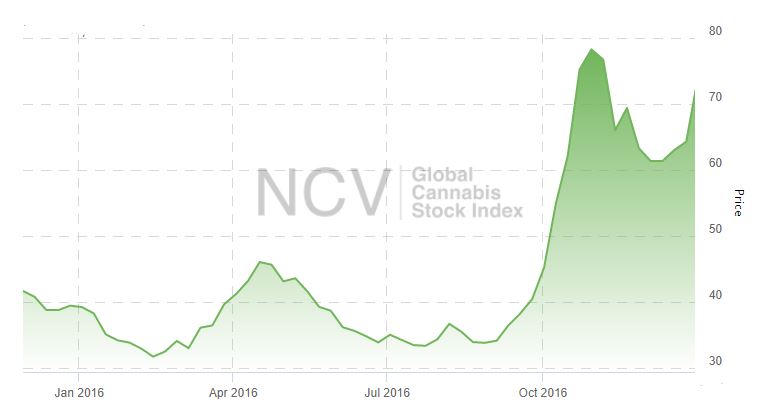You’re reading a copy of this week’s edition of the New Cannabis Ventures weekly newsletter, which we have been publishing since October 2015. The newsletter includes unique insight to help our readers stay ahead of the curve as well as links to the week’s most important news.
Friends,
We have devoted several of our newsletters to discussing how important the upcoming elections are for the industry with respect to both several state legalizations as well as what might happen should the Senate change control. Today, we want to discuss the 2016 elections, their impact on the market at the time and how today’s set-up is quite different than four years ago.
In 2016, five states had ballot initiatives for adult-use legalization, and there were several medical initiatives as well. The most exciting adult-use initiatives were in the country’s largest state by population, California, and in what would be a significant legalization on the East Coast, Massachusetts. Maine was another eastern state voting, while Arizona and Nevada were the other western states. At the time, voters had previously approved legalization in Alaska, Colorado, Oregon and Washington., so this was an opportunity to double the number of states that had legalized. Medical cannabis initiatives were on the ballot in Florida, which had just missed the super-majority threshold of 60% for approval two years earlier, along with Arkansas and North Dakota. Of course, only Arizona ultimately failed to win voter approval.
Many readers may recall the excitement in the market ahead of the elections in 2016. From August 31st to November 2nd, just ahead of the election on November 8th, the New Cannabis Ventures Global Cannabis Stock Index rocketed higher by more than 162%:

This year, the market seemed to kick into rally mode recently on October 8th, after the VP debate, during which Kamala Harris discussed decriminalization. The market is up 13.5% so far in October, but this rally has been very different from 2016. First, September was a terrible month for the stocks, so this rally was later to get started. Second, the rally itself has paled in comparison to 2016 in terms of the percentage gains.
We think that there are several reasons that could explain the relative lack of interest. First, each additional state to legalize seems to become less important from a mathematical perspective. Colorado and Washington were exciting, as they were the first. Since then, the number doubled in 2014 (Alaska and Oregon) and then doubled again in 2016 to 8. 2018 added just two, Michigan and Vermont. There are now 11 legal states, including Illinois, so the number of states could increase by 36%. Evaluating it by looking at the population, the change would be even smaller at 20% more citizens with access to adult-use cannabis. The law of diminishing returns may be at play here as well as the novelty wearing off a bit.
Another reason for less of a market move may be that the market caps of the companies are much higher as well as the floats. Quite simply, it takes a lot more money to move the market today than four years ago.
These companies were very different in many ways from those that are in the index today. Almost all of them traded on the OTC, and many of them were sub-penny stocks. It was a speculative market that didn’t really reflect the real industry. Today, the index has no companies with a primary listing on the OTC. The only stocks that are in the index that trade on the OTC have primary listings in Canada. Several of the stocks in the index are listed on only the higher exchanges in the U.S. None of the companies in the index in 2016 were cannabis operators in the U.S. Today, MSOs represent the largest sub-sector at nearly 40%. The market has evolved.
Finally, the investor base has changed too. In 2016, the typical trader was a penny stock trader. Today, we see many institutions, including family offices, hedge fund, pension funds, ETFs and mutual funds, investing in the space. We think that a more sophisticated investor base along with the higher quality names prevents the kind of outsized move that took place in 2016, when the market was just for speculators, or later in late 2017 ahead of California legalizing.
While we are expecting that many traders will focus on the cannabis sector in the coming days ahead of the election and are excited by the potential for further short-term price appreciation, we believe that this is much more than a short-term trade, as we have discussed previously. Unlike in 2016, when there were few companies trading that could benefit from the outcome of the elections directly, there are many publicly traded operators in Arizona and New Jersey already. New Jersey’s initiative, which is expected to pass, could set off a wave of legalization on the East Coast through the legislative process. All of these states have robust participation already from publicly traded companies.
It’s always a challenge to predict stock prices in the short-term, but, given the muted run-up so far as well as the potential for a real catalyst (more legalization), we believe any sort of “sell-the-news” reaction could be short-lived. Of course, change in the control of the Senate, should that take place, has the potential to bring a lot of investors into the sector, as we discussed last week.
We see a lot of optionality with the market heading into the elections. Status quo seems to be working quite well, and this is likely the worst-case scenario. On the other hand, additional state legalizations, especially New Jersey, will provide more fuel for expansion, while a change in control of the Senate could throw fuel on the fire.
Vireo Health International is a physician-led cannabis company focused on select markets where it has achieved critical mass. Vireo has since doubled down on building a strong intellectual property portfolio and sees IP as its biggest potential upside beyond the company’s multi-state operations. The company manufactures pharmaceutical-grade cannabis products and distributes its products through its growing network of Green Goods™ retail dispensaries and third-party locations.
The company has reduced its cost structure and has sold assets in Pennsylvania and Ohio to focus on its core markets: Arizona, Maryland, Minnesota, New Mexico and New York, all states that it thinks could legalize for adult-use in the intermediate-term.
 Get up to speed by visiting the Vireo Health Investor Dashboard that we maintain on their behalf as a client of New Cannabis Ventures. Click the blue Follow Company button in order to stay up to date with their progress.
Get up to speed by visiting the Vireo Health Investor Dashboard that we maintain on their behalf as a client of New Cannabis Ventures. Click the blue Follow Company button in order to stay up to date with their progress.
New Cannabis Ventures publishes curated articles as well as exclusive news. Here is some of the most interesting business content from this week:
- Aphria Q1 Cannabis Revenue Advances 18% Sequentially
- California Cannabis Operator Indus Holdings Pre-Announces Q3 Revenue Above $14 Million
- CBD Retailer cbdMD Pre-Announces Fiscal Q4 Revenue at $11.5-11.7 Million
- Flower One Pre-Announces Q3 Revenue at $11.5 Million
- Harborside Projects Q3 Revenue to Exceed $18.5 Million
- Intrinsic Capital Partners Raises $102 Million to Deploy Into the Cannabis Industry
- MedMen Q4 Revenue Plunges 40% to $27.4 Million as Losses Mount
- Exclusive: This Cannabis Testing Lab is Building a Profitable Multi-State Business
- Exclusive: Trulieve Is Expanding Within and Beyond the Florida Medical Cannabis Market
- Valens Q3 Revenue Increases 2% Sequentially to $18.1 Million
To get real-time updates download our free mobile app for Android or Apple devices, like our Facebook page, or follow Alan on Twitter. Share and discover industry news with like-minded people on the largest cannabis investor and entrepreneur group on LinkedIn.
Get ahead of the crowd! If you are a cannabis investor and find value in our Sunday newsletters, subscribe to 420 Investor, Alan’s comprehensive stock due diligence platform since 2013. Gain immediate access to real-time and in-depth information and market intelligence about the publicly traded cannabis sector, including daily videos, weekly chats, model portfolios, a community forum and much more.
Use the suite of professionally managed NCV Cannabis Stock Indices to monitor the performance of publicly-traded cannabis companies within the day or over longer time-frames. In addition to the comprehensive Global Cannabis Stock Index, we offer a family of indices to track Canadian licensed producers as well as the American Cannabis Operator Index.
View the Public Cannabis Company Revenue & Income Tracker, which ranks the top revenue producing cannabis stocks that generate industry sales of more than US$10M per quarter.
Stay on top of some of the most important communications from public companies by viewing upcoming cannabis investor earnings conference calls.
Discover upcoming new listings with the curated Cannabis Stock IPOs and New Issues Tracker.
Sincerely,
Alan & Joel
